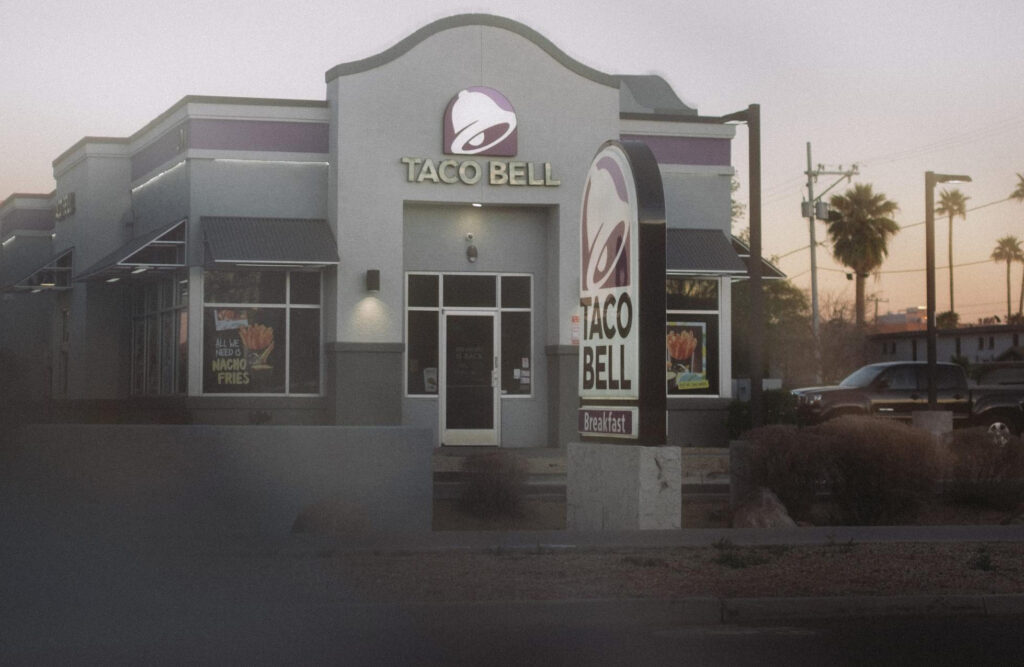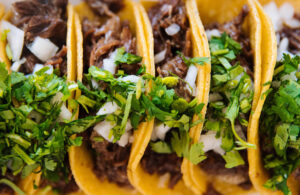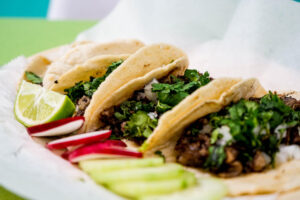19 Sizzling Fun Facts About Taco Bell
Get ready to indulge in some delicious Tex-Mex fast food with Taco Bell! This popular chain of restaurants has been serving up tasty tacos, burritos, and other Mexican-inspired dishes for decades, earning a dedicated following of fans. Here are some interesting facts about Taco Bell:

Taco Bell is a fast-food chain that specializes in Tex-Mex-style cuisine.
1 which combines elements of Mexican and American cuisine. The chain offers a variety of menu items, including tacos, burritos, nachos, quesadillas, and other dishes that incorporate ingredients like beef, chicken, beans, cheese, and various spices and sauces.
The first Taco Bell restaurant was opened in Downey, California in 1962.
2 The restaurant was originally called “Taco Tia” but was later renamed to “Taco Bell” after Glen Bell opened additional locations and decided to franchise the concept.
Today, there are over 7,000 Taco Bell locations worldwide.
The company’s founder, Glen Bell, also founded other fast-food chains.
3 Including Der Wienerschnitzel and Bell’s Hamburgers. Glen Bell was a pioneer in the fast-food industry, and he opened his first restaurant, a hot dog stand called Bell’s Drive-In, in 1948.
Over the years, he experimented with different types of food and eventually developed the concept for Taco Bell. Today, Taco Bell is one of the most popular fast-food chains in the world, and it continues to innovate with new menu items and marketing campaigns.
Taco Bell is currently headquartered in Irvine, California.
4 The company’s headquarters are located in a building known as “The Bell” that was designed to resemble a taco.
 The building features a bell-shaped atrium and a spiral staircase that leads to a rooftop deck with views of Orange County.
The building features a bell-shaped atrium and a spiral staircase that leads to a rooftop deck with views of Orange County.
Taco Bell has been headquartered in Irvine since 1992, when the company moved from its original headquarters in Downey, California.
The company has over 7,000 locations worldwide.
5 Including in the United States, Canada, Mexico, Europe, Asia, and other countries.
The company has grown rapidly since its founding in 1962, and it is now one of the largest fast-food chains in the world.
Taco Bell has a strong presence in the United States, where it operates over 6,500 locations, but it has also expanded aggressively into international markets in recent years.
The company’s global expansion has been driven by a combination of franchising and direct investment in new markets.
In 1978, Taco Bell was acquired by PepsiCo, which was looking to expand its presence in the fast-food industry.
6 Taco Bell was part of the PepsiCo Restaurants division, which also included Pizza Hut and KFC.
Under PepsiCo’s ownership, Taco Bell continued to expand rapidly, and the company introduced several new menu items and marketing campaigns.
In 1997, PepsiCo spun off its restaurants division into a separate company called Tricon Global Restaurants, which later changed its name to Yum! Brands.
Today, Taco Bell is a subsidiary of Yum! Brands, along with KFC and Pizza Hut.
The chain is known for its affordable prices and creative menu items.
7 The company has a reputation for offering a wide range of menu options at reasonable prices, including its popular value menu items.
 Taco Bell has also gained a following for its innovative menu items, such as the Doritos Locos Tacos and the Crunch wrap Supreme, which have become fan favourites.
Taco Bell has also gained a following for its innovative menu items, such as the Doritos Locos Tacos and the Crunch wrap Supreme, which have become fan favourites.
The chain regularly introduces new limited-time menu items to keep customers interested and to create buzz around the brand.
Overall, Taco Bell’s combination of affordability and creativity has helped it to stand out in the crowded fast-food market.
Taco Bell’s menu also includes vegetarian and vegan options.
8 The company has long been known for its vegetarian-friendly options, such as the Bean Burrito and the 7-Layer Burrito, which can be made vegan by requesting no cheese or sour cream.
In recent years, Taco Bell has also introduced new vegetarian and vegan options, such as the Black Bean Crunch wrap Supreme and the Spicy Potato Soft Taco.
The company has been praised for its efforts to cater to a variety of dietary preferences and for offering affordable and flavourful options for customers who are looking for plant-based options.
The company has faced criticism over the years for the quality and nutritional value of its food.
9 Some critics have argued that the chain’s food is overly processed and high in calories, sodium, and fat, and that it can contribute to health problems such as obesity and heart disease.
 In response to these concerns, Taco Bell has made efforts to improve the nutritional profile of its menu items, such as by reducing the sodium content in some of its offerings and introducing new lower-calorie options.
In response to these concerns, Taco Bell has made efforts to improve the nutritional profile of its menu items, such as by reducing the sodium content in some of its offerings and introducing new lower-calorie options.
The company has also launched marketing campaigns to promote the quality and freshness of its ingredients and to highlight its efforts to provide healthier menu choices.
Despite these efforts, however, Taco Bell continues to face scrutiny over the nutritional value of its food and its impact on public health.
In 2011, Taco Bell was sued for false advertising.
10 In 2011, Taco Bell was sued for false advertising after a class-action lawsuit alleged that the company’s seasoned beef contained only 35% beef.
The lawsuit claimed that the rest of the filling was made up of various fillers and extenders, such as water, isolated oat product, wheat oats, and soy lecithin.
Taco Bell vigorously denied the allegations and launched a public relations campaign to defend the quality of its beef. Ultimately, the lawsuit was dismissed after Taco Bell agreed to make changes to its advertising and to disclose the ingredients of its beef filling.
The company also made changes to its recipe to address some of the concerns raised by the lawsuit.
The incident highlighted the importance of transparency and accuracy in food labelling, and it underscored the challenges that fast-food chains face in maintaining consumer trust and confidence.
The company later changed its recipe and launched a marketing campaign to address the controversy.
11 In the wake of the 2011 lawsuit over the content of its seasoned beef filling, Taco Bell made changes to its recipe and launched a marketing campaign to address the controversy.
The company reformulated its beef filling to include more beef and fewer fillers and extenders, and it began advertising the changes in television commercials and on social media.
The company also released a series of print ads that featured a letter from the company’s president apologizing for any confusion caused by the lawsuit and reassuring customers about the quality and integrity of its beef.
The marketing campaign was generally well-received and helped to rebuild some of the trust that the company had lost as a result of the controversy.
Today, Taco Bell continues to promote the quality and freshness of its ingredients and to emphasize its commitment to transparency and accuracy in its labelling and advertising.
Taco Bell has collaborated with other brands and celebrities on limited-time menu items.
12 The chain has a history of partnering with other companies and personalities to create unique and often wacky menu items that generate buzz and excitement among customers.
Some of its notable collaborations have included menu items such as the Doritos Locos Tacos, which was created in partnership with Frito-Lay, and the Mountain Dew Baja Blast Freeze, which was developed in collaboration with PepsiCo.
Taco Bell has also worked with celebrities such as rapper Post Malone and YouTuber Tanya Burr to create their own customized menu items, which are available for a limited time.
These collaborations have been successful in generating media attention and social media buzz for the brand, as well as in attracting new customers who are curious to try the latest limited-time menu items.
The chain has also experimented with more upscale offerings, such as the Cantina Bell menu.
13 Launched in 2012, the Cantina Bell menu was an attempt by Taco Bell to appeal to more health-conscious and discerning customers by offering a higher-quality and more sophisticated menu.
The menu featured items such as bowls, burritos, and salads made with premium ingredients such as fire-grilled chicken, black beans, and avocado ranch sauce.
The menu also included vegetarian and vegan options. The Cantina Bell menu was generally well-received by critics and customers, but it ultimately failed to catch on with the mainstream fast-food audience.
Taco Bell eventually discontinued the Cantina Bell menu, but it has continued to experiment with new menu offerings and to explore new ways to appeal to a wider range of customers.
In 2020, Taco Bell announced that it would be streamlining its menu and discontinuing some popular items.
14 The decision was made in response to feedback from customers and franchisees, who had expressed concerns about the complexity and variety of the menu.
The streamlined menu was intended to simplify the ordering process and to make the kitchen operations more efficient. As part of the menu changes, Taco Bell discontinued several menu items, including the popular Mexican Pizza, as well as items such as the 7-Layer Burrito, the Nachos Supreme, and the Beefy Fritos Burrito.
The decision to discontinue these items was met with some criticism from loyal fans, who expressed disappointment at losing some of their favourite menu items.
However, Taco Bell has emphasized that the menu changes were necessary to improve the overall customer experience and to ensure that the company remains competitive in a crowded fast-food market.
Taco Bell has a loyalty program called “Taco Bell Rewards”
15 The program was launched in 2021 and is designed to reward frequent customers with exclusive discounts, offers, and free menu items.
Customers can sign up for the program using the Taco Bell app or website and earn points for every dollar spent on qualifying purchases.
Points can be redeemed for free food items, such as tacos, burritos, and drinks. The loyalty program also offers members access to special promotions and giveaways, as well as personalized offers and recommendations based on their purchase history and preferences.
The Taco Bell Rewards program is part of the company’s broader efforts to engage with customers and to build lasting relationships with its most loyal fans.
The company has also launched a mobile app that allows customers to order food for pickup or delivery.
16 The app is available for download on both iOS and Android devices and can be used to place orders for pickup or delivery from participating Taco Bell locations.
Customers can browse the menu, customize their orders, and pay for their purchases directly through the app. The app also offers a number of other features, such as the ability to track orders in real-time, save favorite orders and locations, and receive exclusive offers and promotions.
The mobile app is part of Taco Bell’s broader efforts to embrace technology and to offer customers more convenient and flexible ways to order and enjoy their food.
In 2021, Taco Bell announced that it would be testing a plant-based meat alternative made by Beyond Meat.
17 The test was conducted in select locations in Southern California and featured a new menu item called the “Beyond Meat Taco”.
 The taco was made with a seasoned Beyond Meat filling and featured the same toppings as Taco Bell’s classic crunchy taco.
The taco was made with a seasoned Beyond Meat filling and featured the same toppings as Taco Bell’s classic crunchy taco.
The test was intended to gauge customer interest in plant-based meat alternatives and to explore new menu offerings that could appeal to a wider range of customers.
The Beyond Meat Taco was generally well-received by customers and critics, and Taco Bell has indicated that it may expand the test to other locations in the future.
The partnership with Beyond Meat is part of Taco Bell’s broader efforts to offer more plant-based menu options and to appeal to the growing number of customers who are looking for healthier and more sustainable food choices.
The chain is known for its quirky advertising campaigns and slogans.
18 Which have become a hallmark of the brand’s marketing strategy. Some of the company’s most famous slogans include “Think Outside the Bun,” which was used in a series of commercials to promote Taco Bell’s non-traditional approach to Mexican-inspired cuisine, and “Live Mas,” which was introduced in 2012 and has since become a rallying cry for the brand’s younger, millennial customers.
Taco Bell’s advertising campaigns often feature bold, colourful imagery, irreverent humour, and pop-culture references, and are designed to appeal to a diverse range of customers.
The company’s marketing efforts have been widely praised for their creativity and effectiveness, and have helped to establish Taco Bell as one of the most recognizable and beloved fast-food chains in the world.
Taco Bell has a cult following over the years.
19 With fans who are known by a variety of nicknames, such as “Taco Bellies,” “Belluminati,” and “Tacoheads.”
These fans are passionate about the chain’s unique cuisine, creative menu items, and irreverent branding, and often share their love of Taco Bell on social media and in online forums. Some fans even go so far as to create their own custom menu items by combining different items from the regular menu, and these “secret menu” items have become a popular part of Taco Bell lore.
The company has embraced its cult following and has even launched a line of Taco Bell-themed clothing and merchandise, which is sold through its online store.
The company’s fans are an important part of its success, and Taco Bell has been praised for its ability to connect with its customers in meaningful and authentic ways.




